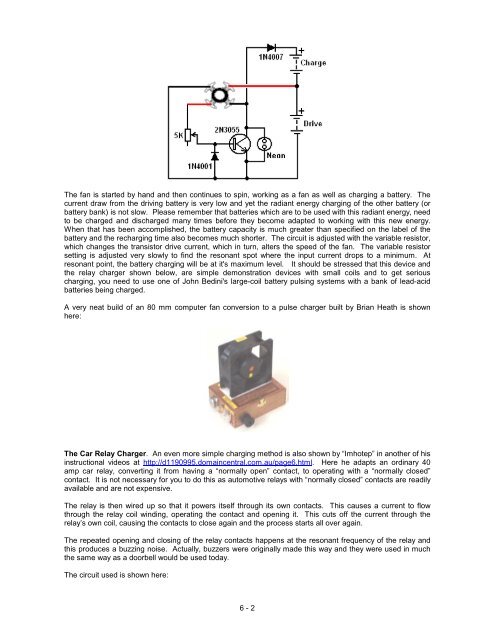6 - 1 The Modified Computer Fan. Other more simple methods of ...
6 - 1 The Modified Computer Fan. Other more simple methods of ...
6 - 1 The Modified Computer Fan. Other more simple methods of ...
You also want an ePaper? Increase the reach of your titles
YUMPU automatically turns print PDFs into web optimized ePapers that Google loves.
<strong>The</strong> fan is started by hand and then continues to spin, working as a fan as well as charging a battery. <strong>The</strong><br />
current draw from the driving battery is very low and yet the radiant energy charging <strong>of</strong> the other battery (or<br />
battery bank) is not slow. Please remember that batteries which are to be used with this radiant energy, need<br />
to be charged and discharged many times before they become adapted to working with this new energy.<br />
When that has been accomplished, the battery capacity is much greater than specified on the label <strong>of</strong> the<br />
battery and the recharging time also becomes much shorter. <strong>The</strong> circuit is adjusted with the variable resistor,<br />
which changes the transistor drive current, which in turn, alters the speed <strong>of</strong> the fan. <strong>The</strong> variable resistor<br />
setting is adjusted very slowly to find the resonant spot where the input current drops to a minimum. At<br />
resonant point, the battery charging will be at it's maximum level. It should be stressed that this device and<br />
the relay charger shown below, are <strong>simple</strong> demonstration devices with small coils and to get serious<br />
charging, you need to use one <strong>of</strong> John Bedini's large-coil battery pulsing systems with a bank <strong>of</strong> lead-acid<br />
batteries being charged.<br />
A very neat build <strong>of</strong> an 80 mm computer fan conversion to a pulse charger built by Brian Heath is shown<br />
here:<br />
<strong>The</strong> Car Relay Charger. An even <strong>more</strong> <strong>simple</strong> charging method is also shown by “Imhotep” in another <strong>of</strong> his<br />
instructional videos at http://d1190995.domaincentral.com.au/page6.html. Here he adapts an ordinary 40<br />
amp car relay, converting it from having a “normally open” contact, to operating with a “normally closed”<br />
contact. It is not necessary for you to do this as automotive relays with “normally closed” contacts are readily<br />
available and are not expensive.<br />
<strong>The</strong> relay is then wired up so that it powers itself through its own contacts. This causes a current to flow<br />
through the relay coil winding, operating the contact and opening it. This cuts <strong>of</strong>f the current through the<br />
relay’s own coil, causing the contacts to close again and the process starts all over again.<br />
<strong>The</strong> repeated opening and closing <strong>of</strong> the relay contacts happens at the resonant frequency <strong>of</strong> the relay and<br />
this produces a buzzing noise. Actually, buzzers were originally made this way and they were used in much<br />
the same way as a doorbell would be used today.<br />
<strong>The</strong> circuit used is shown here:<br />
6 - 2


